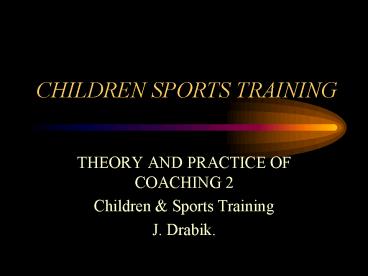CHILDREN SPORTS TRAINING - PowerPoint PPT Presentation
1 / 22
Title:
CHILDREN SPORTS TRAINING
Description:
Squat and arm raise. Sit, pedal feet and move arms in frontal plane ... Partner exercises. Single, alternate leg/arm exercises. 21. Flexibility ... – PowerPoint PPT presentation
Number of Views:583
Avg rating:3.0/5.0
Title: CHILDREN SPORTS TRAINING
1
CHILDREN SPORTS TRAINING
- THEORY AND PRACTICE OF COACHING 2
- Children Sports Training
- J. Drabik.
2
Foundation of sports performance
Top Performance
Physical Fitness
3
Goals of Physical Fitness Training
- To develop a persons functional versatility
- To raise the level of motor abilities
- To prevent the negative result of one-sided,
specialised training loads.
4
Age based training methods
Muscular Fitness
Energy Fitness
5
Beginning Training-Sensitive periods.
- Max strength 12-14(f) 14-16(m)
- explosive strength 10-12(f) 12-14(m)
- Strength Endurance 12-14(f) 14-16(m)
- Aerobic Endurance 8-10 (f m)
- Anaerobic Endurance 12-14(f) 14-16(m)
- Speed of Reaction 8-10 (f m)
- Maximal Speed 10-12(f) 12-14(m)
- Coordination 5-8 (f m)
6
Coordination
- Elements of Coordination
- Balance
- Sense of Rhythm
- Spatial Orientation
- Kinesthetic Differentation
- Reactivity to acoustical and visual signals
7
Coordination
- Goal is to introduce athletes/children to as many
NEW and DIFFERENT movement patterns as possible. - Once developed, motor pattern is stored and can
be more easily retrieved in the future.
8
Coordination
- Balance
- Static balance (eg balance beam)
- Dynamic balance (eg swerving, tumbling)
- Training Examples
- Rotate arms and legs - different directions.
- Squat and arm raise
- Sit, pedal feet and move arms in frontal plane
- Rotations into Airplane positions
9
Coordination
- Sense of Rhythm
- Ability to determine the extent or range of
movements in time appropriate to a given
exercise. - Training Examples
- A, B, C drills ( variations)
- Running over obstacles at uniform distances
10
Coordination
- Spatial Orientation
- Ability to sense the position of your body in
space. - Training Examples
- Ball throw, rotate and catch
- Ball throw overhead and catch behind
- Bouncing two balls whilst performing activity
- Trampoline exercises
- Playing modified games-two balls, smaller field
11
Coordination
- Speed of Reaction
- Ability to quickly respond to stimulus (sight,
touch, sound). - Training Examples
- Catch ball released from partner
- Mirror movement of partner
- Touch partner, move that direction
- move on command from partner
12
Coordination
- Synchronisation of movements
- Ability to have unrelated limb movements occuring
simultaneously - Training Examples
- One arm large circle, hopping, punching other arm
lateral. - Rotate hips and wrists (each in different
direction) - Skip in place, bounce ball, large circle with arm
13
Coordination
- Kinesthetic Differentiation
- Ability to adjust muscular tension to achieve
desired result. - Training Examples.
- Jump set distance, (open and closed eyes)
- Throw balls of varying weight set distances
- Jump over obstacles different heights and
distances
14
Speed
- Speed is reliant upon many factors
- Strength, Power, flexibility, coordination,
reaction time, morphology - Adolescent Growth Spurts can have negative effect
upon speed capacity. - Goals should be in developing correct movement
patterns and stimulating the nervous system
regularly.
15
Speed Principles
- Practice mastered movements faster than the
individuals currently normal speeds. - Go from simple to complex, from easy to
difficult, from known to new. - Combine speed exercises with techniques of the
sport. - Vary exercises regularly - include coordination.
- Vary conditions in which speed exercises are done.
16
Speed Principles
- Prefer doing more sets to increasing the duration
of one set. - Schedule long rest breaks.
- Take advantage of the sensitive periods in
development of speed - Develop reaction time and frequency of movements
early in life, and the forms of speed based on
strength and anaerobic capability later.
17
Speed Principles
- Training Exercises
- Fun is the key to all these training elements
- Running, races and relays
- Reaction exercises with signal
- Uphill, downhill, sand, towing
- Plyometrics emphasising speed off the ground
18
Strength
- Boys increase in strength much faster than girls
from 12-15 years. - Especially shoulders and back muscles
- There is a secondary growth spurt with females
from 17-20. (small of population) - Can lead to rapid decrease in performance
capability.
19
Principles of Strength Training
- Precede strength training with musculoskeletal
evaluation - Focus on functional strength, particularly
postural muscles - Strength training in stages
- General strength
- Functional strength
- Specific strength
20
Exercises for Strength Development
- Obstacle courses
- Climbing, hanging
- Medicine balls
- All body weight exercises
- Plyometric activities
- Partner exercises
- Single, alternate leg/arm exercises
21
Flexibility
- Highest of all physical attributes in children
- Three kinds of flexibility
- Static
- Dynamic
- Static Active
- After 10 years, with the onset of AGS flexibility
decreases rapidly
22
Principles of Flexibility
- Combine flexibility with strength
- Work on specific joints
- Dynamic over static with young children
- Avoid hyperextension exercises where possible.

